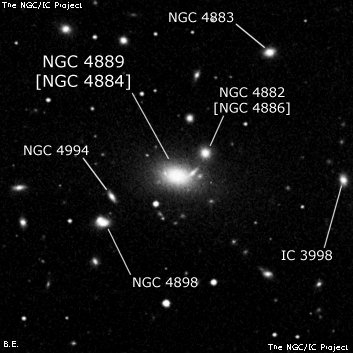
William Herschel discovered NGC 4889 = H II-391 = h1507 on 11 Apr 1785 (sweep 396) and simply not "vF". His position is 3.4' northwest of NGC 4889, close to the same offset he made in the sweep with NGC 4874.
John Herschel made two observations under h1507 (sweep 64 and 343) with his RA is marked as very uncertain. On sweep 343, he recorded "B; pmE; bM. The fourth of 5, south of * 7m. His position is 4 sec of RA too large but his sketch verifies the identity. Also, his observation listed under h1510 on sweep 65 refers to NGC 4889.
Heinrich d'Arrest's NGC 4884 is a duplicate observation. See that number for details. d'Arrest commented that "The nebulae are incredibly numerous and dense and despite being faint, they have a diversity one cannot imagine a priori. Sometimes, in the most favorable moments, I had the very definite impression that the nebulae, often only a few arcseconds in diameter, are intermingled with larger, roung, oblong, star-shaped or cometary ones, like oysters packed together in a barrel."
300/350mm - 13.1" (5/14/83): fairly bright, fairly small, oval E-W. Largest and brightest in AGC 1656 = Coma I. NGC 4874 lies 7' W and several companions are near.
400/500mm - 17.5" (4/21/90): largest and brightest galaxy in AGC 1656 = Coma I galaxy cluster. NGC 4889 and NGC 4874 9.2' W are both surrounded by a cloud of faint galaxies. Moderately bright, fairly small, oval E-W, bright core. Several companions near including NGC 4886 1.0' NW, NGC 4894 1.9' ESE, NGC 4898 2.4' SE which are all collinear with NGC 4889 and IC 4011 1.6' N.
900/1200mm - 82" (5/5/19, McDonald Observatory): at 613x; extremely bright, large, oval 4:3 ~E-W, very strong concentration with a very bright core and an intensely bright nucleus. The halo extends ~1.8'x1.4' and fades out slowly. PGC 44708, an edge-on galaxy, poked out of the west side of the halo towards the NW. It appeared fairly faint, extremely thin, perhaps 7:1 NW-SE, ~28"x4".
Notes by Steve Gottlieb